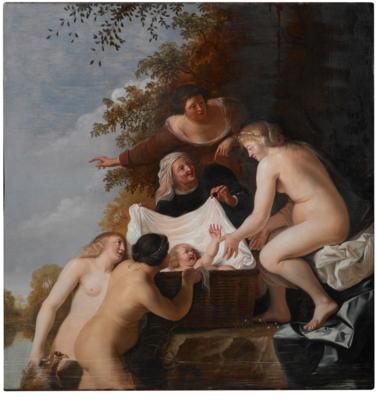Christiaen van Couwenbergh

(Delft 1604–1667 Keulen)
The Finding of Moses,
monogrammed and dated upper right: CB·F- / 1640,
oil on panel, 124 x 118 cm, framed
Provenance:
with Weinmüller, Munich, 1974 (as Netherlandish School, 17th Century);
Private collection, Germany;
sale, Christie’s, Amsterdam, 9 May 2001, lot 130 (as Christiaen van Couwenbergh)
Literature:
W. C. Maier-Preusker, Christiaen van Couwenbergh (1604–1667), in: Wallraf Richartz Jahrbuch, vol. 52, 1991, pp. 193–194, no. A5, fig. 35 (as Christiaen van Couwenberg, dated 1655/57)
The present painting is registered in the RKD database under no. 0000128811 (as Christiaen van Couwenbergh).
The present painting relates to a work on canvas of the same subject by Christiaen van Couwenbergh in the Koninklijke Musea voor Schone Kunsten, Brussels (inv. no. 6763). Both subjects are depicted in a similar theatrical composition, with the figures arranged in a pyramidal scheme. Whereas the Brussels painting shows a certain alienation between the groups of figures, in the case of the present painting, the arrangement of the figures appears a lot more dynamic. Contrary to the biblical account, here, the pharaoh’s daughter appears as a bathing nude, resembling the examples of depictions of ancient goddesses.
Christiaen van Couwenbergh was among the most important artists active in Delft in the first half of the seventeenth century, along with Leonard Bramer (1596–1674) and Michiel van Mierevelt (1566–1641). He is best known for his large wall paintings of allegories and mythological scenes, populated by majestic life-size nudes. He received numerous commissions from the Orange family to decorate the palaces of Honselaersdijk, Nieuburg, and Noordeinde, though his most significant commission was to participate in the decoration of the Oranjezaal of the Huis ten Bosch in The Hague, where he collaborated with all the major Dutch painters of the time, including Gerrit van Honthorst and Jacob Jordaens.
The son of a silversmith and art dealer originally from Malines, Couwenbergh trained in the workshop of Johan van Nes, where the development of his style gravitated away from the influence of the Utrecht Caravaggist painters, including Hendrick ter Brugghen, Dirck van Baburen, and Gerrit van Honthorst, that marked his early years, towards a more classicist style. It is possible that Couwenbergh also trained in Italy, a hypothesis, however, that not all scholars can agree on.
Esperto: Mark MacDonnell
 Mark MacDonnell
Mark MacDonnell
+43 1 515 60 403
oldmasters@dorotheum.com
03.05.2023 - 18:00
- Prezzo realizzato: **
-
EUR 26.000,-
- Stima:
-
EUR 20.000,- a EUR 30.000,-
Christiaen van Couwenbergh
(Delft 1604–1667 Keulen)
The Finding of Moses,
monogrammed and dated upper right: CB·F- / 1640,
oil on panel, 124 x 118 cm, framed
Provenance:
with Weinmüller, Munich, 1974 (as Netherlandish School, 17th Century);
Private collection, Germany;
sale, Christie’s, Amsterdam, 9 May 2001, lot 130 (as Christiaen van Couwenbergh)
Literature:
W. C. Maier-Preusker, Christiaen van Couwenbergh (1604–1667), in: Wallraf Richartz Jahrbuch, vol. 52, 1991, pp. 193–194, no. A5, fig. 35 (as Christiaen van Couwenberg, dated 1655/57)
The present painting is registered in the RKD database under no. 0000128811 (as Christiaen van Couwenbergh).
The present painting relates to a work on canvas of the same subject by Christiaen van Couwenbergh in the Koninklijke Musea voor Schone Kunsten, Brussels (inv. no. 6763). Both subjects are depicted in a similar theatrical composition, with the figures arranged in a pyramidal scheme. Whereas the Brussels painting shows a certain alienation between the groups of figures, in the case of the present painting, the arrangement of the figures appears a lot more dynamic. Contrary to the biblical account, here, the pharaoh’s daughter appears as a bathing nude, resembling the examples of depictions of ancient goddesses.
Christiaen van Couwenbergh was among the most important artists active in Delft in the first half of the seventeenth century, along with Leonard Bramer (1596–1674) and Michiel van Mierevelt (1566–1641). He is best known for his large wall paintings of allegories and mythological scenes, populated by majestic life-size nudes. He received numerous commissions from the Orange family to decorate the palaces of Honselaersdijk, Nieuburg, and Noordeinde, though his most significant commission was to participate in the decoration of the Oranjezaal of the Huis ten Bosch in The Hague, where he collaborated with all the major Dutch painters of the time, including Gerrit van Honthorst and Jacob Jordaens.
The son of a silversmith and art dealer originally from Malines, Couwenbergh trained in the workshop of Johan van Nes, where the development of his style gravitated away from the influence of the Utrecht Caravaggist painters, including Hendrick ter Brugghen, Dirck van Baburen, and Gerrit van Honthorst, that marked his early years, towards a more classicist style. It is possible that Couwenbergh also trained in Italy, a hypothesis, however, that not all scholars can agree on.
Esperto: Mark MacDonnell
 Mark MacDonnell
Mark MacDonnell
+43 1 515 60 403
oldmasters@dorotheum.com
|
Hotline dell'acquirente
lun-ven: 10.00 - 17.00
old.masters@dorotheum.at +43 1 515 60 403 |
| Asta: | Dipinti antichi |
| Tipo d'asta: | Asta in sala con Live Bidding |
| Data: | 03.05.2023 - 18:00 |
| Luogo dell'asta: | Wien | Palais Dorotheum |
| Esposizione: | 22.04. - 03.05.2023 |
** Prezzo d'acquisto comprensivo di tassa di vendita e IVA
Non è più possibile effettuare un ordine di acquisto su Internet. L'asta è in preparazione o è già stata eseguita.
